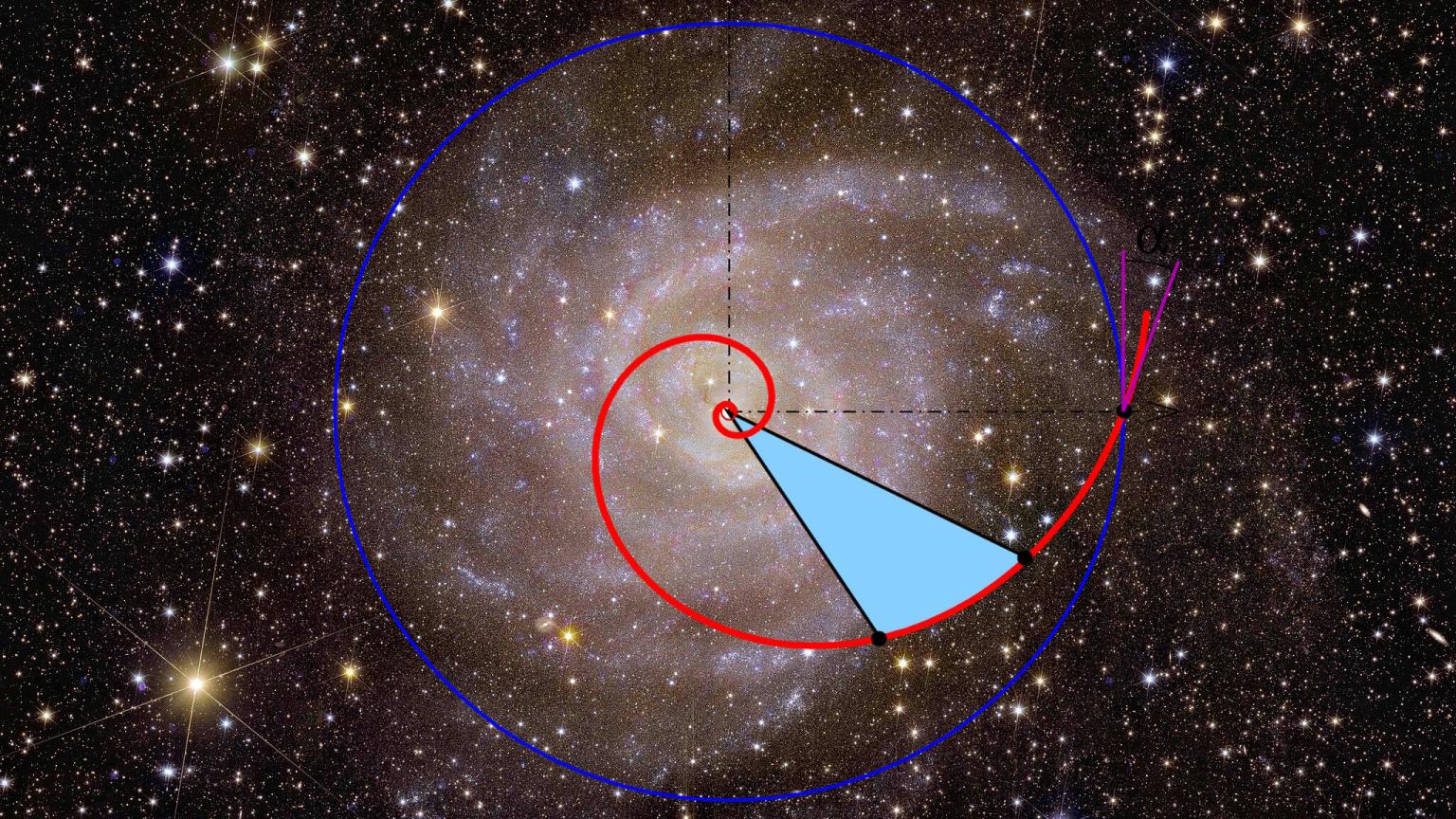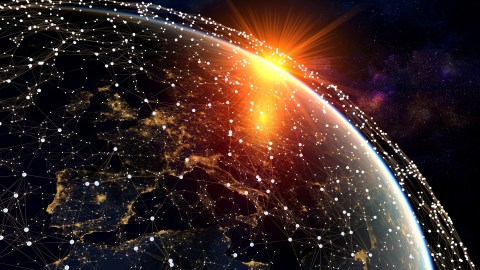- Big Think’s Ethan Siegel on the Fibonacci sequence;
- Big Think’s Adam Frank on biological and technological information flow;
- Shorter items on inflation and human irrationality; how calls for securing the border are political theater; how anti-science (vaccine “hesitancy”) is rising; and how Republicans would reject a border deal rather than lose a campaign selling point.
Here’s an item about mathematics and beauty, and the lure of intelligent design.

Big Think, Ethan Siegel, 19 Jan 2024: Ask Ethan: What explains the Fibonacci sequence?, subtitled “The pattern 1, 1, 2, 3, 5, 8, 13, etc., is the Fibonacci sequence. It shows up all over nature. But what’s the full explanation behind it?”
Key Takeaways
• If you start with the first two numbers in a sequence as “1” and “1,” you can add them together to make the next number, “2,” and then add that new number to the prior number to make the next one. • Named after the Italian mathematician, Leonardo of Pisa (better known as Fibonacci), these numbers often appear in mathematics, computer science, and even nature itself. • Even though it doesn’t explain every “spiral” or recurring and progressive structure, it does explain a lot. Its mathematical roots, however, are both simpler and more complex than you might imagine.
I’m curious what his “complex” roots of this very simple algorithm, but the reason I’m highlighting this is to illustrate a very basic principle: much of what we see in nature as beautiful, is actually the result of very basic biological functions that express simple mathematical relationships. And yet this apparent ‘beauty’ is what many people see as intelligently designed, since such beautiful patterns couldn’t have come about randomly, surely. Yet they do — not randomly, exactly, but based on simple interactions between things in the universe that can be expressed in relatively simple mathematics.
(At the same time, this begs the question of why people see *asymmetry*, at least in limited portions, as equally ‘beautiful,’ in some different sense. Because in some cases symmetry is boring, perhaps.)
Let’s see what Ethan Siegel says.
One of the most fascinating facts about the natural world is that so many entities within it — both biologically and purely physically — obey a specific set of patterns and ratios. Many galaxies exhibit spiral shapes and structures, as do a wide variety of plant structures: pinecones, pineapples, and sunflower heads among them. Ammonites, shelled animals that went extinct more than 60 million years ago, also show that spiral pattern, where one of the key features of spirals is that the next “wind” around outside the prior one displays a specific length ratio to the size of the prior, interior winding.
That ratio, in any such structure, is often extremely close to the ratio of two adjacent numbers found in the Fibonacci sequence. This mathematical sequence, often taught to children, simply starts with the numbers “0” and “1” and then gets the next term in the sequence by adding the two prior terms together. It’s arguably the most famous mathematical sequence of all, but what explains the sequence’s pattern, and is it truly, inextricably linked to nature? … Indeed, simply looking at the “spiral” structures in galaxies might appear to be Fibonacci-like, but is that real, or just our minds making superfluous connections where only an apparent link exists?
His answer: patterns in spiral galaxies are seldom Fibonacci-like. (This would because the forces that shape galaxies are so much more complex than the elementary biological functions that create one spiral loop based on the next.) And the same point is made regarding other spiral shapes — “from whirlpools and vortices that form in bodies of water to the aerial shapes of hurricane clouds and clear lanes”. Our perceptions see things that are not actually there.
The Fibonacci-like patterns seen in spiral galaxies are inventions of our eyes, rather than a physical truth of the Universe.
This of course is an example of how humans perceive patterns where they don’t exist.
The article then goes into some technical detail about how the algorithm of basing one spiral loop on the next is efficient, but it’s not scalable. Rather, the most efficient scheme reflects — much math here — the golden ratio. More math and diagrams, which I’m not going to completely absorb. Conclusion:
Or, in other words, that the original sequence, i.e., the sum of the numbers in the Fibonacci sequence sorted by decimal places, equals 0.1/8.9, or 1/89. And that’s why the Fibonacci sequence isn’t inherent to nature, but rather, to pure mathematics instead. It appears in nature because the golden ratio has a biological utility, but wherever it appears in the physical sciences, including in some spiral galaxies, it’s only by pure coincidence!
Our intuitions — including our sense of beauty — mislead us.
\\\
I just finished the new book by Adam Frank, THE LITTLE BOOK OF ALIENS, which I will write here about soon. Here he is at Big Think.

Big Think, Adam Frank, 19 Jan 2024: Biology or technology: Which moves more information per second?, subtitled “The answer is set to change in the year 2113, a recent estimate suggests.”
Key Takeaways
• Traditional views of life emphasize biological processes like reproduction and metabolism. However, you can also understand life by focusing on its capacity to deliberately use and transfer information, a process that distinguishes it from non-living systems. • A recent paper estimated the total amount of information transferred per second by all life on Earth. • To contextualize this estimate, astrophysicist Manasvi Lingam also conducted similar estimates for the total amount of information transferred per second by all technology on Earth. The estimates suggest life moves more information per second than technology — but that could change in the next century.
So you can anticipate his conclusion. Along the way, he invokes ideas from the book I just read: biosphere, Vladimir Vernadsky, technosphere. Conclusion:
So, by 2113 the human-built technosphere will move more bits than the biosphere (from which humans emerged). What will that mean? What will crossing that threshold signal for the evolution of our species and the evolution of the planet? That is a great question which I don’t have an answer for yet. But, just as important, we could not even formulate that question if we hadn’t taken this global view of information and life. That’s the power of a new perspective.
\\\
Shorter items.
Humans are not rational.
NY Times, Paul Donovan, 18 Jan 2024: Why Are Voters So Upset? Consider the Snickers Bar.
The United States has just experienced one of the biggest collapses in consumer inflation in modern history. In June 2022 consumer prices had risen 9.1 percent over the previous year. By December 2023 the rate of increase had slowed to 3.4 percent. And yet, in survey after survey, voters still declare inflation to be at or near the top of their list of concerns.
Why aren’t voters recognizing the decline in the inflation rate? Because voters are humans, and humans don’t think about inflation rationally. To understand why, let’s look at a Snickers bar.
\
Washington Post, Eduardo Porter, 18 Jan 2024: Opinion | Forget about securing the border. It won’t work.
Calls to “secure the border” have never been anything but political theater — slogans to prove commitment to a safe homeland. Migrants have kept coming regardless, pushed from precarious lives, and pulled by the promise of security and economic progress in the United States.
Managing migration demands a different conversation, one that focuses less on the border’s impregnability and more on the mechanisms and incentives driving people toward it; one that speaks of the coordination needed with other countries on the migration path to jointly manage the flow of people across the hemisphere; one that takes account of migrants’ contribution to the nation’s prosperity.
Washington, unfortunately, is incapable of this kind of talk. The Biden administration seems out of ideas. And standing behind a standard-bearer deploying xenophobia as a selling point in a hotly contested bid for reelection, Republican calls to “secure the border” amount to little more than a political bludgeon.
\
CBS News, 18 Jan 2024: How fringe anti-science views infiltrated mainstream politics — and what it means in 2024
About vaccine hesitancy. Again, is America going down the drain through rejection of science and rejection of democracy?
\
Washington Post, Catherine Rampell, 19 Jan 2024: Opinion | House Republicans try to blow up the border deal they claim to want
As noted a couple days ago: Republicans don’t want to solve problems if doing so would benefit the Democrats in any way — or in this case, if solving the problem would take away a campaign selling point.





